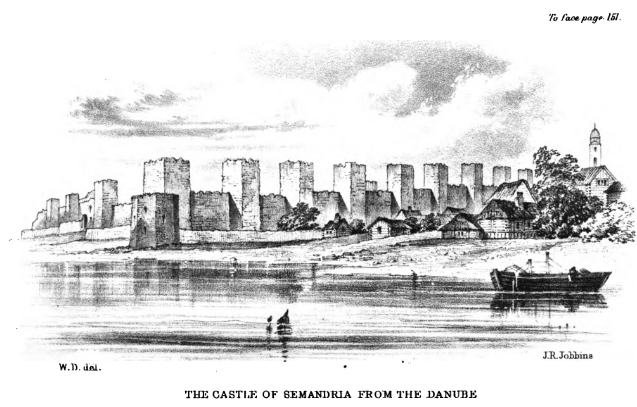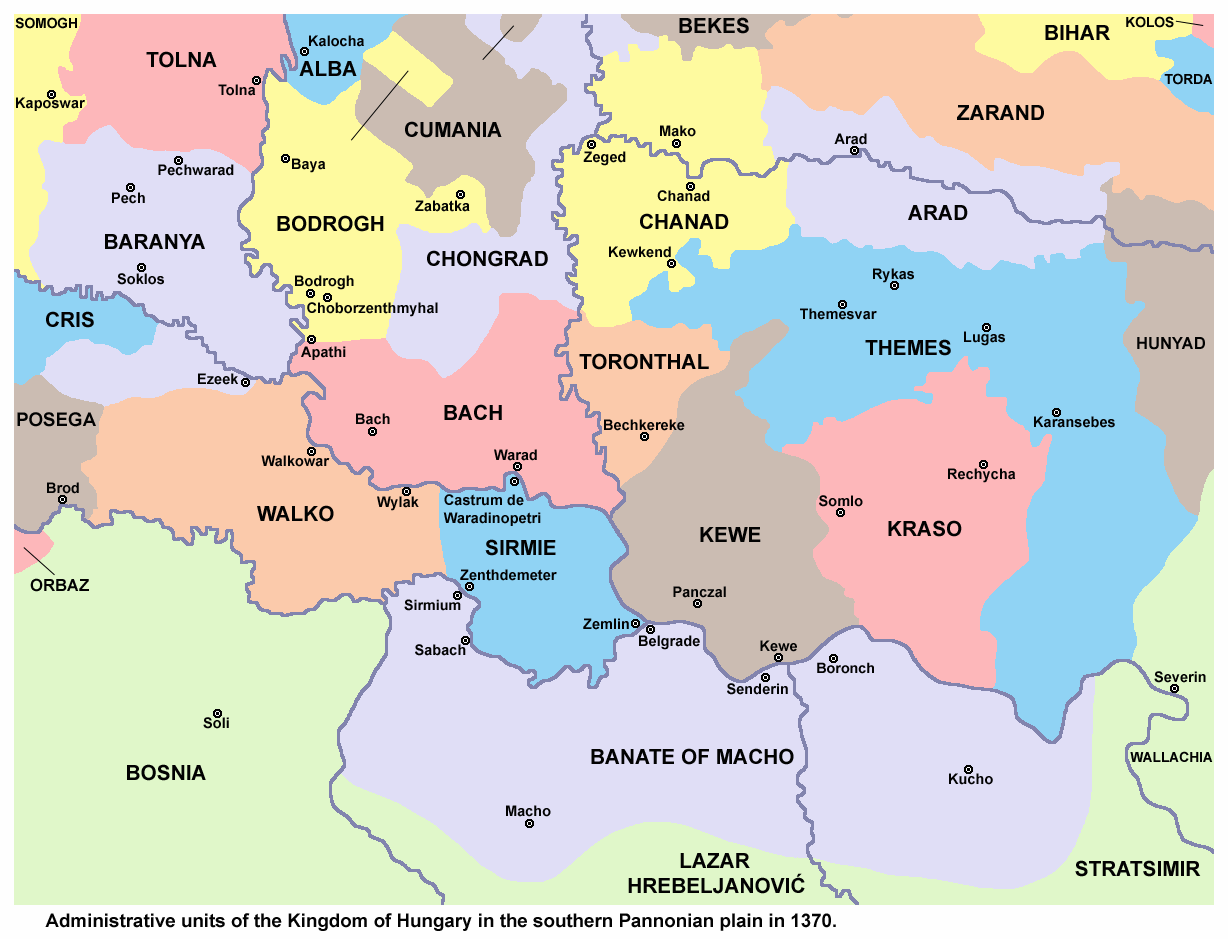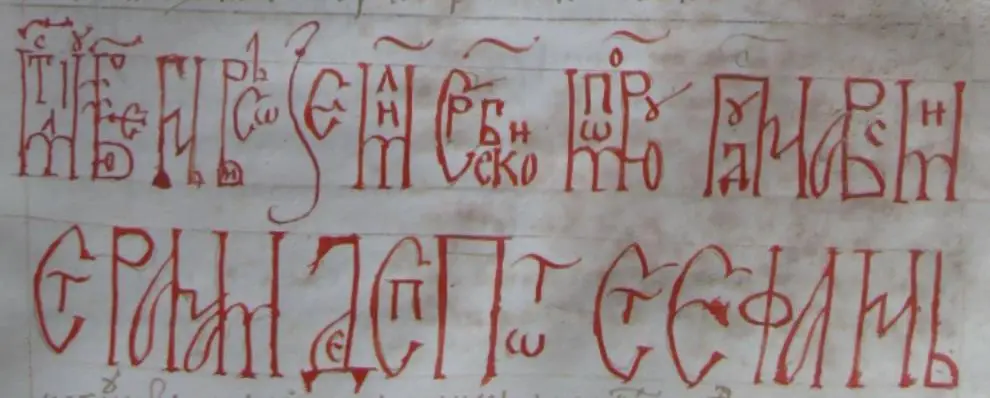SERVIA,
YOUNGEST MEMBER OF THE EUROPEAN FAMILY:
OR, A
RESIDENCE IN BELGRADE,
AND
TRAVELS IN THE HIGHLANDS AND WOODLANDS OF THE INTERIOR,
DURING THE YEARS 1843 AND 1844.
BY
ANDREW ARCHIBALD PATON, ESQ.
CHAPTER VI.
Europeanization of Belgrade.—Lighting and Paving.—Interior of the Fortress—Turkish Pasha.—Turkish Quarter.—Turkish Population.—Panorama of Belgrade—Dinner party given by the Prince.
The melancholy I experienced in surveying the numerous traces of desolation in Turkey was soon effaced at Belgrade. Here all was life and activity. It was at the period of my first visit, in 1839, quite an oriental town; but now the haughty parvenu spire of the cathedral throws into the shade the minarets of the mosques, graceful even in decay. Many of the bazaar-shops have been fronted and glazed. The oriental dress has become much rarer; and houses several stories high, in the German fashion, are springing up everywhere. But in two important particulars Belgrade is as oriental as if it were situated on the Tigris or Barrada—lighting and paving. It is impossible in wet weather to pay a couple of visits without coming home up to the ankles in mud; and at night all locomotion without a lantern is impossible. Belgrade, from its elevation, could be most easily lighted with gas, and at a very small expense; as even if there be no coal in Servia, there is abundance of it at Moldava, which is on the Danube between Belgrade and Orsova; that is to say, considerably above the Iron Gates. I make this remark, not so much to reproach my Servian friends with backwardness, but to stimulate them to all easily practicable improvements.
One day I accompanied M. de Fonblanque on a visit to the Pasha in the citadel, which we reached by crossing the glacis or neck of land that connects the castle with the town. This place forms the pleasantest evening lounge in the vicinity of Belgrade; for on the one side is an extensive view of the Turkish town, and the Danube wending its way down to Semendria; on the other is the Save, its steep bank piled with street upon street, and the hills beyond them sloping away to the Bosniac frontier.
The ramparts are in good condition; and the first object that strikes a stranger on entering, are six iron spikes, on which, in the time of the first revolution, the heads of Servians used to be stuck. Milosh [1] once saved his own head from this elevation by his characteristic astuteness. During his alliance with the Turks in 1814, (or 1815,) he had large pecuniary transactions with the Pasha, for he was the medium through whom the people paid their tribute. Five heads grinned from five spikes as he entered the castle, and he comprehended that the sixth was reserved for him; the last head set up being that of Glavash, a leader, who, like himself, was then supporting the government: so he immediately took care to make the Pasha understand that he was about to set out on a tour in the country, to raise some money for the vizierial strong-box. “Peh eiu,” said Soliman Pasha, thinking to catch him next time, and get the money at the same time; so Milosh was allowed to depart; but knowing that if he returned spike the sixth would not wait long for its head, he at once raised the district of Rudnick, and ended the terrible war which had been begun under much less favourable auspices, by the more valiant but less astute Kara Georg.
We passed a second draw-bridge, and found ourselves in the interior of the fortress. A large square was formed by ruinous buildings. Extensive barracks were windowless and tenantless, but the mosque and the Pasha’s Konak were in good order. We were ushered into an audience-room of great extent, with a low carved roof and some old-fashioned furniture, the divan being in the corner, and the windows looking over the precipice to the Danube below. Hafiz Pasha, the same who commanded at the battle of Nezib, was about fifty-five, and a gentleman in air and manner, with a grey beard. In course of conversation he told me that he was a Circassian. He asked me about my travels: and with reference to Syria said, “Land operations through Kurdistan against Mehemet Ali were absurd. I suggested an attack by sea, while a land force should make a diversion by Antioch, but I was opposed.” After the usual pipes and coffee we took our leave.
Hafiz Pasha’s political relations are necessarily of a very restricted character, as he rules only the few Turks remaining in Servia; that is to say, a few thousands in Belgrade and Ushitza, a few hundreds in Shabatz Sokol and the island of Orsova. He represents the suzerainety of the Porte over the Christian population, without having any thing to do with the details of administration. His income, like that of other mushirs or pashas of three tails, is 8000l. per annum. Hafiz Pasha, if not a successful general, was at all events a brave and honourable man, and his character for justice made him highly respected. One of his predecessors, who was at Belgrade on my first visit there in 1839, was a man of another stamp,—the notorious Youssouf Pasha, who sold Varna during the Russian war. The re-employment of such an individual is a characteristic illustration of Eastern manners.
As my first stay at Belgrade extended to between two and three months, I saw a good deal of Hafiz Pasha, who has a great taste for geography, and seemed to be always studying at the maps. He seemed to think that nothing would be so useful to Turkey as good roads, made to run from the principal ports of Asia Minor up to the dépôts of the interior, so as to connect Sivas, Tokat, Angora, Konieh, Kaiserieh, &c. with Samsoun, Tersoos, and other ports. He wittily reversed the proverb “El rafyk söm el taryk” (companionship makes secure roads) by saying, “el taryk söm el rafyk” (good roads increase passenger traffic).
At the Bairam reception, the Pasha wore his great nishau of diamonds. Prince Alexander wore a blue uniform with gold epaulettes, and an aigrette of brilliants in his fez. His predecessor, Michael, on such occasions, wore a cocked hat, which used to give offence, as the fez is considered by the Turks indispensable to a recognition of the suzerainety of the Porte.
Being Bairam, I was induced to saunter into the Turkish quarter of the town, where all wore the handsome holyday dresses of the old fashion, being mostly of crimson cloth, edged with gold lace. My cicerone, a Servian, pointed out those shops belonging to the sultan, still marked with the letter f, intended, I suppose, for mulk or imperial property. We then turned to the left, and came into a singular looking street, composed of the ruins of ornamented houses in the imposing, but too elaborate style of architecture, which was in vogue in Vienna, during the life of Charles the Sixth, and which was a corruption of the style de Louis Quatorze. These buildings were half-way up concealed from view by common old bazaar shops. This was the “Lange Gasse,” or main street of the German town during the Austrian occupation of twenty-two years, from 1717 to 1739. Most of these houses were built with great solidity, and many still have the stucco ornaments that distinguish this style. The walls of the palace of Prince Eugene are still standing complete, but the court-yard is filled up with rubbish, at least six feet high, and what were formerly the rooms of the ground-floor have become almost cellars. The edifice is called to this day, “Princeps Konak.” This mixture of the coarse, but picturesque features of oriental life, with the dilapidated stateliness of palaces in the style of the full-bottom-wigged Vanbrughs of Austria, has the oddest effect imaginable.
The Turks remaining in Belgrade have mostly sunk into poverty, and occupy themselves principally with water-carrying, wood-splitting, &c. The better class latterly kept up their position, by making good sales of houses and shops; for building ground is now in some situations very expensive. Mr. Fonblanque pays 100£. sterling per annum for his rooms, which is a great deal, compared with the rates of house-rent in Hungary just over the water.
One day, I ascended the spire of the cathedral, in order to have a view of the city and environs. Belgrade, containing only 35,000 inhabitants, cannot boast of looking very like a metropolis; but the environs contain the materials of a good panorama. Looking westward, we see the winding its way from the woods of Topshider; the Servian shore is abrupt, the Austrian flat, and subject to inundation; the prospect on the north-west being closed in by the dim dark line of the Frusca Gora, or “Wooded Mountain,” which forms the backbone of Slavonia, and is the high wooded region between the Save and the Drave. Northwards, are the spires of Semlin, rising up from the Danube, which here resumes its easterly course; while south and east stretch the Turkish quarter, which I have been describing.
There are no formal levees or receptions at the palace of Prince Alexander, [2] except on his own fête day.[3] Once or twice a year he entertains at dinner the Pasha, the ministers, and the foreign consuls-general. In the winter, the prince gives one or two balls.
One of the former species of entertainments took place during my stay, and I received the prince’s invitation. At the appointed day, I found the avenue to the residence thronged with people Who were listening to the band that played in the court-yard; and on arriving fit the top of the stairs, was led by an officer in a blue uniform, who seemed to direct the ceremonies of the day, into the saloon, in which I had, on my arrival in Belgrade, paid my respects to the prince, which might be pronounced the facsimile of the drawing-room of a Hungarian nobleman; the parquet was inlaid and polished, the chairs and sofas covered with crimson and white satin damask, which is an unusual luxury in these regions, the roof admirably painted in subdued colours, in the best Vienna style. High white porcelain urn-like stoves heated the suite of rooms.
The company had that picturesque variety of character and costume which every traveller delights in. The prince, a muscular middle sized dark complexioned man, of about thirty-five, with a serious composed air, wore a plain blue military uniform. The princess and her dames de compagnie wore the graceful native Servian costume. The Pasha wore the Nizam dress, and the Nishan Iftihar; Baron Lieven, the Russian Commissioner, in the uniform of a general, glittered with innumerable orders; Colonel Philippovich, a man of distinguished talents, represented Austria. The archbishop, in his black velvet cap, a large enamelled cross hanging by a massive gold chain from his neck, sat in stately isolation; and the six feet four inches high Garashanin, minister of the interior, conversed with Stojan Simitch, [4] the president of the senate, one of the few Servians in high office, who retains his old Turkish costume, and has a frame that reminds one of the Farnese Hercules. Then what a medley of languages; Servian, German, Russian, Turkish, and French, all in full buzz!
We proceeded to the dining-room, where the cuisine was in every respect in the German manner. When the dessert appeared, the prince rose with a creaming glass of champagne in his hand, and proposed the health of the sultan, acknowledged by the pasha; and then, after a short pause, the health of Czar Nicolay Paulovitch, acknowledged by Baron Lieven; then came the health of other crowned heads. Baron Lieven now rose and proposed the health of the Prince. The Pasha and the Princess were toasted in turn; and then M. Wastchenko, the Russian consul general rose, and in animated terms, drank to the prosperity of Servia. The entertainment, which commenced at one o’clock, was prolonged to an advanced period of the afternoon, and closed with coffee, liqueurs, and chibouques in the drawing-room; the princess and the ladies having previously withdrawn to the private apartments.
My time during the rest of the year was taken up with political, statistical, and historical inquiries, the results of which will be found condensed at the termination of the narrative part of this work.
[1] Tran. note: Miloš Obrenović, the leader of the Second Serbian Uprising, Knez (Prince) of Serbia 1817-1839 and 1858-1860. Miloš Obrenović was a pig merchant who stood out in the First Serbian Uprising (1804-1813) and rose to the position of vojvoda (military leader, nobility rank would be similar to a Duke). One of the few remaining vojvodas after the defeat of the First Serbian Uprising, Miloš was able to deftly negotiate increased rights for Serbia. In 1817, after the Second Serbian Uprising, he had Karađorđe, the leader of the First Serbian Uprising, killed in order to prevent loss of power and Ottoman concessions. Although an autocrat, Miloš ended feudalism in the first year of his reign and created the new, independent peasant class of society. During his first reign, the first Serbian constitution (1835 Sretenje Constitution) was written, but was revoked after 100 days after a joint threat by the Austrian, Russian and Ottoman Empires as being too liberal, including anti-slavery clauses. In his second reign, he persecuted political opponents who he saw responsible for this exile and the first law about legislature was passed, starting the parliamentary system in Serbia. Even though he was illiterate, 82 schools, 2 semi-gymnasiums, 1 gymnasium and the Liceum of the Principality of Serbia were founded during his first reign.
[2] Tran. note: Aleksandar Karađorđević, younger son of Karađorđe. Aleksandar returned to Serbia in 1839 and became an adjutant to Mihailo Obrenović, Knez of Serbia 1839-1842 and 1860-1868. Aleksandar became the Knez in 1842 after the Ustavobranitelji (defenders of the constitution) managed to depose Knez Mihailo and his reign was marked by the influence of that group, which is why the period is also called the Ustavobranitelji regime. In 1858, his abdication was secured due to conflicts in internal politics with the State Council.
[3] Tran. note: Slava is a Serbian tradition of celebrating a family’s patron saint. As of 2014, it is on the UNESCO Represntative List of the Intangible Cultural Heritage of Humanity.
[4] Tran. note: Stojan Simić, a strong proponent of consitutional rule, Simić was one fo the most prominent and fiery of the Ustavobranitelji, having been a leader of the Mileta Uprising in 1835, which led to the Sretenje Constitution the same year. At various times, he was a politician in Serbia, in exile in Wallachia where he was a successful merchant and the president of the Senate. His house was bought by the state in 1843 to serve as the court for Knez Aleksandar Karađorđević, with the function continuing with the return of the Obrenović dynasty to power in 1859 until the May coup in 1903. The house was torn down in 1904.



